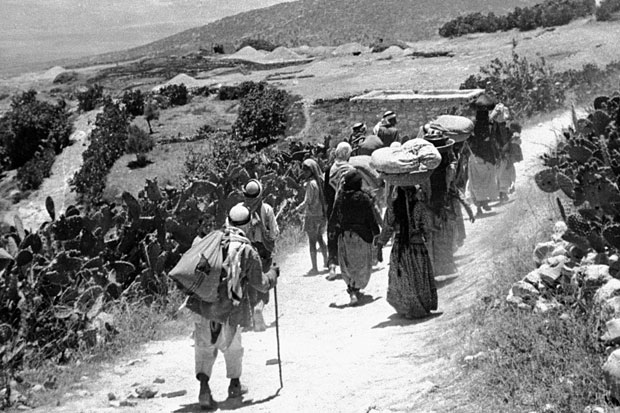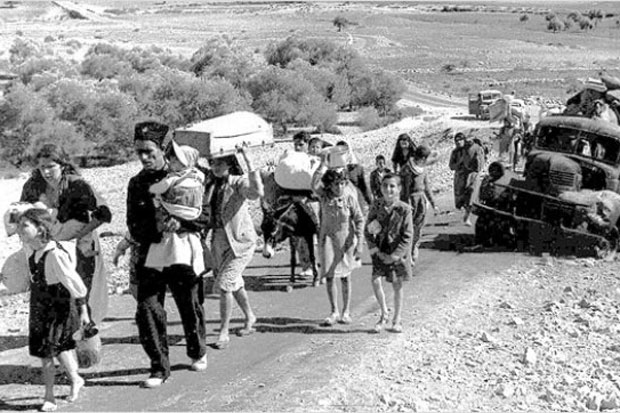On May 14, 1948, the leaders of the Zionist movement in Palestine declared the establishment of the State of Israel. On May 15, Palestinians mark the Nakba – the Catastrophe. What is considered a day of celebration for the Israelis is considered a day of mourning for Palestinians. In this article, I want to explain why that is.
Readers should not find it too hard to understand the contrast. In Australia, whilst many Australians celebrate Australia Day, many Aboriginal people mourn it. The arrival of the First Fleet in 1788 may be a proud moment for some: it marks the beginning of a cruel invasion for the Indigenous population.
Similarly, in the United States of America, there are many who don’t celebrate, but mourn the arrival of Christopher Columbus. Like Australia and the United States, the creation of Israel was founded on the destruction of the Indigenous society that already lived there.
After the UN partition resolution was passed by the General Assembly in 1947, a civil war began in Palestine. And then after Israel declared independence, it was invaded by surrounding Arab armies.
Over the course of the civil war – and then war – some 700,000 Palestinians who had been living in what was once Palestine were displaced from their homes.
Those Palestinians, and their descendants, number some five million today, mostly living in miserable conditions in the countries surrounding Israel and the occupied territories.
For decades, the official Israeli story was that the Palestinians were not expelled from their homes. It was claimed that they left because Arab commanders broadcast orders that they leave, with the added explanation that the Palestinians left so that it would be easier for the Arabs to kill all the Jews.
The position of the Palestinians, obviously, was that they had been expelled from their homes.
In 1961, Erskine Childers demonstrated that there was no evidence for Israel’s claim that the Palestinians fled because of broadcasted orders from other Arab countries. However, it wasn’t until the 1980s that the Israeli position became completely untenable. This was because Israel began to open the archives of its government and military during those fateful early years.

Tom Segev and Simha Flapan were among the ‘New Historians’ who showed that the archival record was inconsistent with the official story Israel had been promoting for decades on the refugee question.
The leading scholar on the issue was Benny Morris, whose important archival discoveries irreversibly changed scholarly debate on the issue. In particular, he found an Israeli intelligence report, analysing why Palestinians were fleeing Palestine, up to 1 June 1948. At this point, some 391,000 Palestinians were estimated to have already fled.
The report attributed 70 per cent of Palestinian flight to military attacks by the Haganah (major Israeli militia, which became the Israeli army after Israel was founded) and right wing Zionist terrorist gangs, the Irgun and LEHI.
Other factors included expulsions of Palestinians (allegedly accounting for some two per cent at this point), general fear, and Zionist psychological warfare.
Arab orders for evacuation accounted for five per cent of Palestinian flight. In Morris’s analysis, the report understates the role of Zionist expulsion of Palestinians.
In Righteous Victims, Morris notes that after this period, there was “far less ‘spontaneous’ flight. Most of the exodus at this time was due to clear, direct causes, including brutal expulsions and deliberate harassment.”
In Birth of the Refugee Problem Revisited, Morris argues that the implementation of Plan Dalet from April 8 or 9 meant “taking off the gloves”: “from early April, operational orders for attacks on villages and clusters of villages more often than not called for the destruction of villages and, implicitly or explicitly, expulsion.”
Unlike Ilan Pappe and Walid Khalidi, Morris does not regard Plan Dalet as a plan to ethnically cleanse Palestine.
Some scholars, notably Norman Finkelstein, and later Shlomo Ben Ami, criticised Morris for not drawing strong enough conclusions from the evidence he cited.
Morris claimed that Israel’s expulsion of the Palestinians was born of war, not design. Palestinian scholar Nur Masalha argued that Benny Morris had not properly taken into account the long history of “transfer” thought in Zionism – that is, the fact that basically every major Zionist thinker favoured expulsion of the Palestinians.
Morris essentially conceded this point to Masalha, and in his updated book on the creation of the refugee question that Morris published in 2004, he devoted a chapter to the subject, called “The idea of ‘transfer’ in Zionist thinking before 1948”.
Morris asks, “How was the Zionist movement to turn Palestine into a ‘Jewish state’ if the overwhelming majority of its inhabitants were Arabs? And if, over the years, by means of massive Jewish immigration, the Jews were at last able to attain a majority, how could a truly ‘Jewish’ and stable polity be established containing a very large, and possibly disaffected, Arab minority, whose birth rate was much higher than the Jews? The obvious, logical solution lay in Arab emigration or ‘transfer’.”
Morris notes that in public, Zionists didn’t speak like that, but “in private, the Zionist leaders were more forthcoming… most advocates of transfer kept their thoughts to themselves, or restricted them to private letters and internal Zionist deliberations.”
Morris called the “logic” of transfer “ineluctable; without some sort of massive displacement of Arabs from the area of the Jewish state to be, there could be no viable ‘Jewish’ state.” And so, “by 1936, the mainstream Zionist leaders were more forthright in their support of transfer”, which was also supported by the British Peel Commission, which had inquired into the massive Palestinian uprising against Zionism.
Whilst Morris concluded that this was not “pre-planning” of the expulsion that later took place, transfer was inevitable and built into Zionism – because it sought to transform a land which was ‘Arab’ into a ‘Jewish’ state, and a Jewish state could not have arisen without a major displacement of Arab population; and because this aim automatically produced resistance among the Arabs which, in turn, persuaded the Yishuv’s leaders that a hostile Arab majority or large minority could not remain in place if a Jewish state was to arise or safely endure.
Given that Morris’s perspective is rather close to that of Ilan Pappe, who has argued that a straight line can be drawn from the support for expulsion of the Palestinians, to the actual expulsion, the room for debate on what happened would seem to be rather narrow.
Once the Palestinian exodus had begun en-masse, the Zionists sought to consolidate their perceived gains. On 28 May, 1948 Moshe Shertok – later Moshe Sharrett, Israel’s second prime minister – sanctioned the creation of an unofficial Transfer Committee. Its members were Yosef Weitz, Ezra Danin and Elias Sasson.
Before it was created, Danin wrote to Weitz of the need for an “institution whose role will be… to seek ways to carry out the transfer of the Arab population at this opportunity when it has left its normal place of residence”.
Weitz explained to Shertok that the Transfer Committee would work “to hammer out a plan of action designed [to achieve]the goal of transfer”. Morris writes that Weitz claimed that Shertok “congratulated him on his initiative and agreed that the ‘momentum [of Arab flight]must be exploited and turned into an accomplished fact’.”
On 5 June, the Transfer Committee met with Ben-Gurion, Israel’s first Prime Minister, to discuss their three-page memo. It was called “Retroactive Transfer, A Scheme for the Solution of the Arab Question in the State of Israel”.
The memo explained their goal: Israel “must be inhabited largely by Jews, so that there will be in it very few non-Jews.”
“The uprooting of the Arabs should be seen as a solution to the Arab question… and, in line with this, it must from now on be directed according to a calculated plan geared toward the goal of ‘retroactive transfer’.”

It made concrete recommendations for achieving these goals:
“(1) Preventing the Arabs from returning to their places.
(2) [Extending] help to the Arabs to be absorbed in other places.”
On preventing the Arabs from returning to their places, the memo proposed:
“(1) Destruction of villages as much as possible during military operations.
(2) Prevention of any cultivation of land by them [i.e., the Arabs], including reaping, collection [of crops], picking [olives]and so on . . .
(3) Settlement of Jews in a number of villages and towns so that no “vacuum” is created.
(4) Enacting legislation [geared to barring a return].
(5) [Making] propaganda [aimed at non-return].”
Morris notes that on 6 June, Weitz wrote to Ben-Gurion: “I… take the liberty of setting down your answer to the scheme proposal I submitted to you, that… B) You agree that the actions marked in clauses 1, 2 [i.e., the destruction of villages and the prevention of Arab cultivation]… begin immediately.”
The fact that many readers will be unfamiliar with these facts is indicative of the success of step 5 above: Israeli propaganda to prevent return of the refugees. It should be noted that Morris is a Jewish, Israeli and Zionist historian, whose political sympathies can be gauged from the fact that he supported the expulsions, and lamented that Israel’s first prime minister didn’t expel all the Palestinians.
However, though the evidence of what happened is very strong, not much has changed politically. The expulsion of the Palestinians in the Nakba is still treated as controversial in the West.
Israel has made no amends for the expulsions. It refuses to allow any of the Palestinians it expelled to return to their homes, to provide them with compensation for the theft and destruction of their properties, or even to apologise, let alone admit responsibility.
During negotiations for a peace agreement between Israel and the Palestinians in 2008, Israel’s Foreign Minister, Tzipi Livni rejected Israel accepting any responsibility for the creation of the refugee problem, and rejected Israel compensating the refugees.
She held that “Compensating refugees is an international matter”, thus, “reference to responsibility would be wrong”. Israel would only note the “suffering” of Palestinians if Palestinians would also acknowledge the suffering of Israelis or Jews.
Israel proposed to accept 1,000 refugees for five years on “humanitarian” grounds only, and would only contribute to compensation schemes.
The Palestinian negotiators seemed to broadly accept the principles behind these proposals: Saeb Erekat only wanted a “symbolic number” of Palestinian refugees to return. Mahmoud Abbas reportedly offered an “extremely low proposal for the number of returnees”.
Meanwhile, in Israel, the High Court upheld a law which allows the government to financially penalise government-funded organisations which commemorate the Nakba.
As there are still millions of refugees, and Israel’s process of ethnic cleansing within Israel and in the Occupied Territories continues, it is important to remember the Nakba.
And it is important we don’t just remember it on May 15, because as in 1948, the ethnic cleansing of Palestinians doesn’t just take place on that one day.
* Readers are encouraged to engage in respectful, reasonable debate. Readers who abuse others and breach the forum rules may have their accounts deleted without notice.
Donate To New Matilda
New Matilda is a small, independent media outlet. We survive through reader contributions, and never losing a lawsuit. If you got something from this article, giving something back helps us to continue speaking truth to power. Every little bit counts.




